

watch DIABLO
Save Mount Diablo
Preserving the Mountain Since 1971 Spring 2011 No. 51
Water District Purchases Ackerman Major Acquisition in Brentwood’s Western Hills
Last summer, when Save Mount Diablo considered purchasing the 5-acre Dry Creek property near Brentwood, we were gambling a little. Dry Creek almost backs up on Cowell Ranch State Park but it fronts the 390-acre Ackerman or “Catholic Church” property across Briones Valley Road.
Mrs. Ackerman left her property to the Oakland Diocese around 1980. The property is beautiful and important as endangered species habitat. It extends from Deer Valley Road east to Briones Valley Road and has a flat valley filled with seasonal wetlands and drained by Dry Creek, a double ridge at the property’s center, and a higher rolling plateau of oak savannah. Sandwiched between Ackerman and the State Park are seven small parcels, three of them undeveloped, one of which is Dry Creek.
Five Houses That Will Never Be Built SMD Acquires 5 Parcels In One Day
December 17, 2010 was a great day. In November, Save Mount Diablo had been working on two acquisitions, one of a single 20-acre parcel, the other of four ten-acre parcels. Negotiations with their owners came to a head and we completed purchase agreements for both properties in a single week. The properties’ owners pushed for quick closes. Given their deadlines and the holidays, from the signing of the purchase offers our due diligence took just three weeks and we closed escrow on all five parcels on December 17th. Five parcels in one day— that’s a new record for SMD.
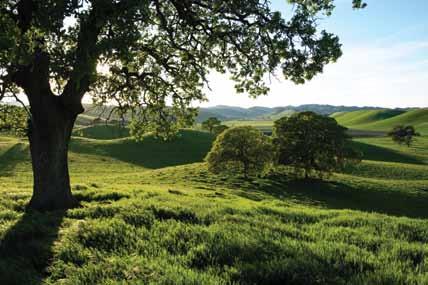
We had been thinking about the ‘Catholic’ property for years. It was one of the reasons we opposed the developer sponsored Measure F on the June 2010 ballot, which would have expanded Brentwood’s urban limit line to the boundary of Ackerman, increasing speculative pressure on it. Luckily, we and the residents of Brentwood prevailed.
Small parcels don’t usually equal large properties’ collections of resources. Their development however, can represent very large threats to resources, or to nearby park areas from house sites, fragmentation, and especially from impacts on aesthetics. By law, individual residential and agricultural parcels have the right to construction of one house, administratively and without public comment. In addition, the twenty acre parcel could eventually have been subdivided.
Our purchase of the five parcels means that five or more large, visually prominent houses will never be built. Plus,
View from Contra Costa Water District’s recently protected Ackerman (or “Catholic”) property west to Deer Valley, Roddy Ranch, and Black Diamond Mines Regional Preserve.Board of Directors
Malcolm Sproul
President
Amara Morrison
Secretary
Burt Bassler
Treasurer
Arthur Bonwell
Emeritus
Heath Bartosh
Charla Gabert
John Gallagher
Claudia Hein
Scott Hein
David Husted
Doug Knauer
Brian Kruse
Dave Sargent
David Trotter
Staff
Ronald Brown
Executive Director
Seth Adams
Land Programs Director
Julie Seelen
Development Director
Monica Oei
Finance Director
Jodi Bailey
Land Conservation Manager
George Phillips
Land Conservation Associate
Beryl Anderson
Communications Coordinator
Emily Egan
Event & Volunteer Coordinator
Christine Chestnut
Grant Writer
Nora Sanchez
Accounting Associate
Shannon Grover
Senior Admin. Assistant
Dana Halpin
Administrative Assistant
Publisher
Save Mount Diablo 1901 Olympic Blvd. Ste 320 Walnut Creek, CA 94596 925-947-3535; fax 925-947-0642
www.SaveMountDiablo.org
Founded in 1971, Save Mount Diablo has helped expand preserved natural lands on and around the mountain from 6,788 acres to more than 100,000 acres
Proud Member of
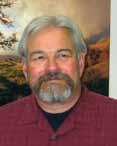
From the Executive Director:
When I began working for Save Mount Diablo nearly 11 years ago, we were happy when we accomplished a new land acquisition every two or three years. What a difference a decade makes - this past December we were able to close escrow on five parcels in one day to preserve 60 acres!
In addition to acquisition, even more acres are protected from development through the land use planning process. As a result of our involvement in passing the 2006 countywide transportation sales tax, every city in Contra Costa County is now required to have its own voter approved Urban Growth Boundary.
In spite of the collapse of the housing market and the trend away from sprawl development, last year we responded to ballot measures aimed at expanding Urban Growth Boundaries in Brentwood and San Ramon. By working with our allies and concerned citizens in both of these cities, we defeated the measures with significant majorities voting to “hold the line.” Subsequently, the Ackerman property, 390 acres adjacent to the contested Urban Growth Boundary in Brentwood, has been preserved by the Contra Costa Water District (see article on page 1). And, following the defeat of the San Ramon Urban Growth Boundary measure, some of the same lands are now being proposed for development through the county. We will continue to discourage development in this area until significant portions of the Tassajara hills are preserved (see article on page 4).
Our land conservation efforts often take many steps over a long period of time – from introducing ourselves to a land owner or reviewing a development application to ultimately preserving the land, building trails or restoring native habitat. Because of the long term commitment from you, our supporters, and the hundreds of volunteers that assist with a variety of projects, we are able to remain vigilant. As a result the preserved lands on and around Mount Diablo continue to increase.
Thank you to all of our friends, volunteers, supporters and donors for their continued loyalty and generosity. With your support, we continue to build relationships, engage in a variety of projects and achieve results that enhance the quality of life in our community. Together, we can and will preserve, defend and restore Diablo’s wilderness so it can be enjoyed by all of us and by future generations.
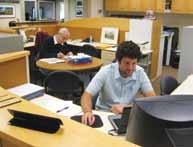


Save Mount Diablo’s New Office - Stop by for a Visit
Thanks to the generosity of organizations and individuals, we received gently used office furniture and equipment for our new office. Volunteers customized the furniture into ideal work spaces to meet staff and volunteer needs. Save Mount Diablo’s office is now set up for efficiency and productivity with plenty of room for our volunteers to assist with a variety of projects.
Special Thanks to:
Contra
Volunteers: Dick Heron • John Gallagher • Dave Frane • Steve Towle • Tommy McCormack
Ray Mengel • Jim Felton • Bob Cooper • Dave Sargent

How to View Magee Ranch and Short Ridge
Trails: Shady Slope, Short Ridge and Sand Hill Trails
Distance: about 2.75 miles round trip
Elevation Gain/Loss: 466 feet
Time: 60 to 90 minutes
Start: Option 1 -- North Sherburne Hills Rd., north of Camino Tassajara Option 2 – North end of Holbrook Drive, north of Camino Tassajara Water/restrooms at trail heads. Dogs ok.
Sycamore Valley Regional Open Space Preserve (SVROSP) in Danville includes two major ridgelines south of Mount Diablo, near Camino Tassajara Rd. This hike takes you onto Short Ridge in the Park’s northern unit, with a short but challenging 20 minute walk to the top. The rewards are 360-degree views including Mount Diablo.
For this self-guided hike, park at the north end of Sherburne Hills Rd. and take the Shady Slope trail up to the Short Ridge. To the west, you see the rolling hills of Short Ridge and across San Ramon Valley to Las Trampas. South you see the Sherburne hills unit of the park. East, the view stretches from Highland Ridge to Altamont Pass. To the north is Mount Diablo.
would be constructed from Diablo Road. and smaller entrances near DiabloClydesdale and south of the DiabloMcCauley intersection. The project includes a trail on Green Valley Creek.
There are three ways to view the site. Seventy-four acres stretch along the south side of Diablo Rd., east from the intersection with Green Valley Rd. Except for one pocket of flatter land near the Green Valley intersection, it’s too steep for proposed development across from St. Timothy’s Episcopal Church. Before your hike, stop at McCauley, then at St. Timothy’s, to view these parts of the proposed development. (See map)
SummerHill’s plans locate most homes south of Green Valley Creek further east, along lower portions of the property, and preserve a significant amount of open space on steeper hillsides (not to be confused with already-developed Magee Ranch to the east). One hundred nineteen acres would be developed with 291 acres as open space.
right of the barn, should be eliminated from the plan and a wider creek buffer required.
It is open to debate whether or not the Magee Ranch property should be developed. The development plan is consistent with the town’s zoning and the site plan is reasonable, but many town residents have voiced concern about impacts. Ultimately, Danville residents will decide. An Environmental Impact Report (EIR) is being prepared.
The last way to view Magee Ranch is the most enjoyable; it focuses on the upper, open-space portion which would not be developed. The new open space would be adjacent to other homeowner association open space and SVROSP. The northwest corner of the preserve resulted from a similar land dedication of Woods Ranch development.
Northwest is the top of 410-acre Magee Ranch, site of 78 proposed houses by SummerHill Homes. A main entrance
To see that area, walk up Athenian School hill between Blackhawk Road and the upper ball fields or drive a quarter mile up Southgate Road into the State Park. South is the Magee Ranch barn. To the left, is the already developed Magee Ranch. Imagine the flats left and right of the barn covered in housing. Larger lots rising up the canyon,
No part of this hike is on Magee Ranch; it simply provides views of the Ranch. The more informed the public and decision makers are, the better the decisions that will be made.
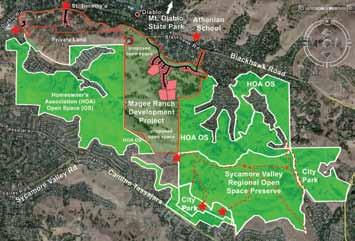
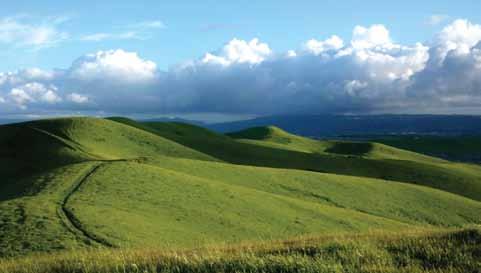
San Ramon Rejects Measure W by a Landslide 72% of Voters Defend the Tassajara Valley
For the second time in 2010, voters rejected an attempt to break and expand an urban growth boundary, this time in San Ramon. The city tried to grab 1,624 acres, or nearly half of the Tassajara Valley, in addition to other areas. With 72% opposing, San Ramon residents slammed Measure W with a resounding “No” vote. In June, Brentwood residents similarly rejected Measure F, which would have expanded that city’s urban limit line by 740 acres. It was the fourth vote in twelve years to protect the Tassajara Valley--but developers haven’t given up yet.
San Ramon residents are owed a big debt of thanks, as are the campaign volunteers, especially co-chairs Phil O’Loane, Sally Scholl, and Doug Burr. Equally important was the involvement of Save Mount Diablo and Greenbelt Alliance, the two largest campaign donors, and the Sierra Club’s Bay Chapter. (O’Loane, the former Chairman of the San Ramon Planning Commission who was removed when he raised questions about Measure W, recently joined Save Mount Diablo’s Land Committee.)
For twenty years, Save Mount Diablo and others have been defending the Tassajara Valley and hills, sensual grasslands stretching east of Danville’s
Blackhawk and San Ramon’s Dougherty Valley, an agricultural buffer south of Mount Diablo State Park and Morgan Territory Regional Preserve.
We expected to face Seattle-based developer consultant Tom Koch and his Jordanian land speculator client Samir Kawar, who have proposed the 771-acre “New Farm” project in the Tassajara Valley and outside of county and city urban limit lines. Koch was also the sponsor of Brentwood’s failed measure. They had second thoughts, but the San Ramon City Council and City Manager Herb Moniz pursued Measure W nonetheless. Opponents had to campaign with the idea that Koch-Kawar might suddenly dump large amounts of funding into the campaign, and had to overcome biased mail sent by the city to every household.
San Ramon sponsors of Measure W, especially the city council--Mayor Abram Wilson (who was also running for State Assembly), Dave Hudson, Dave Livingstone, Scott Perkins, and Carol Rowley, and Planning Commissioners Harry Sachs and Eric Wallis--made numerous tactical errors. Rather than a simple question of whether to expand the city’s Urban Growth Boundary in three locations, they attempted to hide their key goals by placing the entire 2030 General Plan on the ballot, including the controversial North Camino Ramon Specific Plan. Residents from throughout the city found something to dislike in the Plan.
Meanwhile, opponents ran both a strong technical and grassroots campaign. We opened a campaign office and hired activist Brenda de la Osa as a field manager to run it, volunteers walked and dropped literature at nearly every house in the city, and we sent out four mail pieces. We even won the campaign “sign wars.”
Issues included concerns over the Tassajara Valley and other open space, the sheer amount of growth San Ramon was proposing despite 4,600 already approved houses that haven’t yet been built, the city’s lack of transparency and attempts to fool voters, and impacts on crowded schools and utility rates. Revelations about city staff salaries and pensions, including that City Manager Herb Moniz is the highest paid city manager in the state (despite heading a relatively small city), undermined the city’s credibility and helped gain opposing endorsements from the Contra Costa Times and other media.
“New Farm” Proposed
If Measure W had passed, thousands of houses could have been built in the Tassajara Valley by Koch-Kawar and others, but they haven’t given up yet. Koch-Kawar filed an application for their “New Farm” project with Contra Costa County in July 2007, but then failed to complete their application until February 2011. It would include million dollar houses and olive orchards, and was used by Measure W supporters as a scare tactic although the county application would only include 187 units.
Though posing the project as “agricultural” and “rural residential”, if approved it would in fact break the county urban limit line and open the flood gates for similar projects. An environmental impact report is being prepared. Koch is counting on influencing county supervisor elections early next year to help move his project forward. Save Mount Diablo and our allies will continue to defend the Tassajara Valley and to oppose urban limit line-busting projects. We’ll keep you posted.
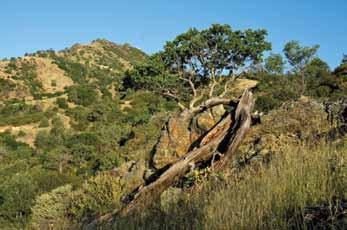
Viera – North Peak:
Preserved with your help!
“You do the thing that you can do that is an expression of who you are, and an expression of your sense of relationship to nature, to the environment. You do the thing that you can do, I’ll do the thing that I can do, and we’ll try to get these people to do what they can do, and together we can save ourselves.”
John DenverYou did it! The campaign to fund the acquisition of Viera-North Peak was successful – even surpassing its goal!
You may recall that in 2009, we purchased “Viera-North Peak” – 165 acres of spectacular chaparral, oak woodlands and streams right on the slopes of Mount Diablo’s second highest point, North Peak. More than 55 rare plant species, like the Mount Diablo jewel flower, and several rare animal species, like the Alameda whip snake, have been sighted there.
To raise the $1 million needed to purchase the property, we launched a capital campaign. Before we even got underway, Jeanne Thomas came by our office. Jeanne hikes every week, often on the mountain. She has supported Save Mount Diablo for nearly twenty years. When Save Mount Diablo staff
“If we all help a little, it will mean a lot.”
- Natalie & Al
1,542 Friends of Gary donated $121,280 to save the mountain.
announced the purchase agreement on the Viera property at one of its committee meetings, Jeanne was very quiet. A few days later, she came and simply said “I want to help fund the Viera acquisition. I have never made a donation this big but this property, with its wild flowers, a property that was so dear to Mary Bowerman, it’s so exciting – this is worth it!”
Then, the campaign took off. The Board of Directors stepped up, Dana and Dave Dornsife made a lead gift and many of our wonderful supporters soon followed. Everyone doing what they could and all excited to be a part of saving this incredible piece of the mountain.
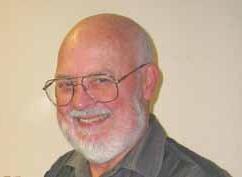
In the Fall, Gary Bogue did his part by encouraging his readers to do what they could: “Viera-North Peak is a treasure that absolutely must be protected, no matter what it takes. That’s why I, and hopefully my caring readers, will do everything we can to help you raise those funds.”
And Gary’s readers cared! They sent in their donations, small and large, to help save another piece of the mountain. Many readers sent in notes along with their donations. Jackie, a long time local resident, wrote: “Dear Gary, been looking at that wonderful mountain for 58 years –it hasn’t changed much, and I want to do my part to keep it that way.” And even
new residents to the East Bay donated – Clenie and Phil wrote: “We’re not sure yet which one of these lovely surrounding hills is Mt. Diablo – but whatever. We agree. Let’s save it!”
Steve Lesher, one of the Directors of the Dean and Margaret Lesher Foundation, sent a letter to Gary: “I’ve been moved by your campaign. I am also constantly inspired by the work of Save Mount Diablo, whose efforts to preserve some of our most breathtaking landscapes have made open space a unique part of our regional identity.” His gift from the Lesher Foundation matched donations up to $10,000 as a challenge to spur others to support Save Mount Diablo too – and giving they did.
A total of 1,542 Friends of Gary donated anywhere from $1 to $10,000 for a total of $121,280! And with that, the goal of the capital campaign was exceeded and we can now start work on the transfer of the property to a public agency so it can be enjoyed by the public forever.
This year, as Save Mount Diablo is celebrating its 40th anniversary, we are energized by the outpouring of support we receive from the community. We will continue to do the things that we can do, encourage you to do the things you can do, and together we can save the mountain!
Thank you for making a difference and supporting our work to protect the mountain now and for the future.
So many wonderful supporters gave to this campaign that we cannot name them all here. You can find them listed on our website’s Viera - North Peak page under Land, Acquisition at www.SaveMountDiablo.org
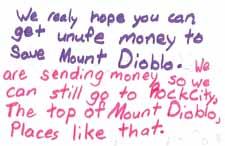
A note from eight year old donor Taylor
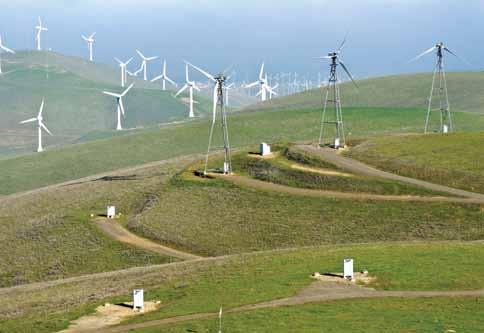
Wind Turbines and Wildlife
Raptors, Repowering, and the True Costs of Clean Energy
by Jodi BaileyThe Altamont Pass area of the Diablo Range (or inner Coast Range) is a great place for hiking and bird watching. Almost universally, anyone who hikes from Diablo south or east, at Hidden Valley, Morgan Territory, Los Vaqueros or Brushy Peak, has seen large birds floating overhead: red-tailed hawks, kites and kestrels, burrowing owls and turkey vultures, among others.
If you are really lucky, perhaps you have even spotted a golden eagle or peregrine falcon. Altamont Pass is at the center of the largest concentration of nesting golden eagles in the world. It looks like they are flying almost effortlessly and aimlessly, anywhere they want to go, looking for prey and places to perch. Year round winds funneling toward the Pass serve as invisible standing waves, upthrust at every hill and ridgeline, allowing birds to hunt while using very little energy.
The area is also a great place for windmills – technically, wind turbine generators – and there’s a big push for expanded “clean” energy sources. Unfortunately, wind turbines and birds, especially raptors, do not mix very
well. The thousands of wind turbines that cover the hilltops in the state-designated Altamont Pass Wind Resource Area (APWRA) have been responsible for a heavy toll on birds; thousands are killed every year. Avian species particularly at risk from the spinning turbine blades are raptors (hawks, kestrels, golden and bald eagles, and peregrine falcons), burrowing owls, and bats.
Beginning in the late 1970s, conditional land-use permits were issued by counties authorizing installation of wind turbines in the cattle ranching grasslands in the Altamont area (a portion of which is in eastern Contra Costa County, though the majority lies in Alameda County).
At the time, little was known about how wind turbines might affect bird populations and, as a result of the energy crisis of that era, there was considerable interest in developing alternative sources of energy. The wind turbines were placed in the Altamont Pass area because of its strategic location as the low point between the Bay
Area and the Central Valley. The hot, dry rising valley air acts like a vacuum, sucking cooler, moist air eastward, from the coast through the pass. This results in consistent, moderate to high wind levels, which are ideal for generating power from wind.
The Altamont is also a very strategic place for migrating birds, occupying a prime location on the Pacific Flyway. So, in addition to the variety of resident bird populations, seasonally, thousands of birds make their north-south and south-north journeys through the area. The open grasslands are particularly attractive to birds of prey that feast on the ground squirrels and other rodents that are abundant throughout the grasslands in the APWRA. It is this plentiful supply of rodents that often brings the birds into fatal contact with the wind turbines.
In December of last year, a settlement agreement was reached between the Bay Area chapters of the Audubon Society, the California attorney general’s office and NextEra Energy, Inc., the largest turbine operator in the APWRA. Audubon and the attorney general’s office were seeking to force either a reduction in avian mortality or removal of the wind turbines.
Under the terms of the settlement, NextEra agreed to reduce avian mortality by 50 percent, which it hopes to fulfill by removing several thousand old wind turbines and replacing them with far fewer, but much larger turbines. NextEra’s strategy also includes placing the turbines in areas less risky for birds.

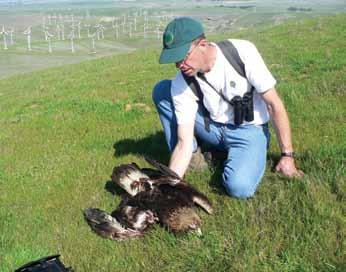
One of the first projects to come up for re-issuance of conditional use permits, known as repowering, is the Vasco Winds project. It is adjacent to Los Vaqueros Reservoir on the southeast and is south of East Bay Regional Park’s Vasco Caves Regional Preserve. NextEra will replace about 435 old turbines at the site with up to 50 new ones (in the most likely scenario, the number is between 35 and 40).
The existing turbines are built in a variety of shapes and heights, with the tallest some 150 feet high. The new turbines, however, are 450 feet tall and at a rating of 2.3 megawatts each, can generate as much or slightly more power than the hundreds of turbines they will replace. The smaller number of turbines will also result in removing many service roads that will no longer be needed.
The differences are stark. Some hilltops currently look like they’re crowned with a dozen oil derricks, every one of them served by a dirt road which may cause significant erosion. Those dozen towers might be replaced by a single streamlined tower with just one road. Visually there could be significant benefits, although larger turbines will also be visible from longer distances.
In developing its site plan for the repowering at Vasco, NextEra worked with Sean Smallwood, a scientist from U.C. Davis. He has conducted extensive research on raptors and their flight behavior with an eye toward
identifying the most and least risky wind turbine locations for birds. Apparently, though it seems like birds are flying around wherever whim takes them, they actually use air space in very specific ways related to ground terrain—around hills and through low spots, for example, where they might be blind-sided by a turbine.
Smallwood and other scientists developed digital terrain models and models of flight behavior for key bird species and mapped the two together using Geographic Information System technology which they combined with substantial statistical analysis.
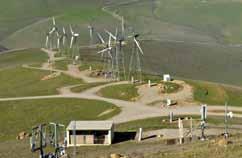
Site criteria for wind turbines also went into the mix. The results of this “micrositing” project were risk maps for wind turbines. By using these models and maps, NextEra has avoided what are thought to be the most risky areas for birds, while placing the turbines in spots that are still favorable for generating wind power.
While the research of Smallwood and others is sophisticated and state-ofthe-art, it is not entirely clear that this approach will solve the problems with avian mortality. The new turbines are much taller, and consequently, have much longer blades. The circle made by the blades spinning around the
central hub on the tower, known as the wind swept or rotor swept area, will actually be slightly increased at Vasco by the repowering project. Some scientific research on bird/wind turbine interactions suggests that wind swept area is the key variable in determining the number of birds that will be killed.
There is very little data on how bat species, many of which are protected, will be impacted. Also less well understood and often overlooked in assessments of wind energy farms on the environment are impacts to terrestrial species. The Vasco Winds site is habitat for numerous federal- and state-listed threatened and endangered species, including the San Joaquin kit fox, Alameda whipsnake, California tiger salamander, and California redlegged frog. Construction impacts might be significant although total terrestrial impacts should decrease.
Visitors and users of Vasco Caves Regional Preserve and Los Vaqueros Reservoir may also be impacted by the presence of the wind turbines, which are aesthetically industrial in character.
The repowering project at the Vasco site is particularly important since what happens there is likely to establish parameters for repowering over the next few years throughout the rest of the Altamont, in both Contra Costa and Alameda counties.
SMD is working with the county, CCWD, East Bay Regional Park District, and NextEra to reduce impacts. Monitoring data will help show how effective the new repowering techniques are in decreasing impacts.

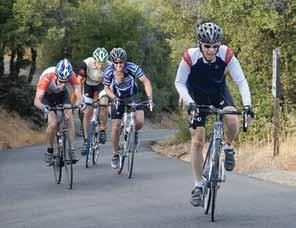

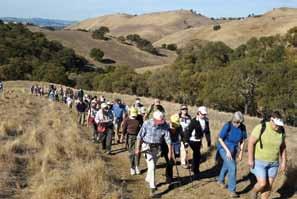
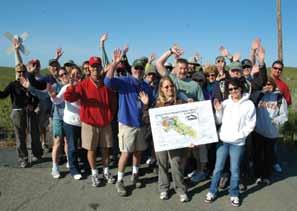
Preserve Defend
Mount Diablo Challenge October 2, 2010
For the 29th year nearly 1,000 cyclists climbed 11.2 miles up the slopes of Mount Diablo using human power, determination, and a love for the mountain.
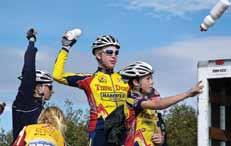



Hikes
2010 and 2011
Hundreds of hikers joined us to enjoy guided tours at favorite Mount Diablo spots and unique opportunities to view rarely seen areas around the mountain.
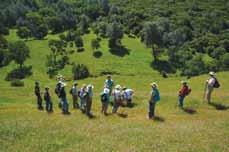
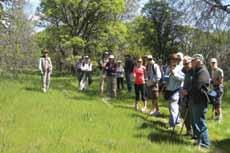
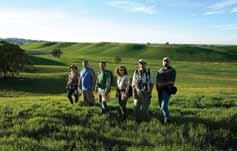
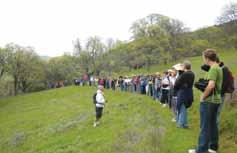 (Clockwise) The last uphill push for the finish line; young members of the Tieni Duro team tossing water bottles to a crowd of fellow cyclists; SMD Development Director, Julie Seelen and Rise to the Challenge winner, Charles Orr, with his prize Zipp wheels; cyclists enjoy the fair at the Lower Summit while awaiting awards; event sponsor Taleo had 43 team members ride Diablo; top female cyclists,Susannah Breen and Jenny Slawta, receiving their awards on stage.
(Clockwise) The last uphill push for the finish line; young members of the Tieni Duro team tossing water bottles to a crowd of fellow cyclists; SMD Development Director, Julie Seelen and Rise to the Challenge winner, Charles Orr, with his prize Zipp wheels; cyclists enjoy the fair at the Lower Summit while awaiting awards; event sponsor Taleo had 43 team members ride Diablo; top female cyclists,Susannah Breen and Jenny Slawta, receiving their awards on stage.
Restore Enjoy
Trail Adventure & Diablo Trails Challenge
November 5, 2010 and March 19, 2011
Runners were undeterred by weather and exhilarated by the wild beauty they found along Mount Diablo’s challenging trails and varied landscapes.
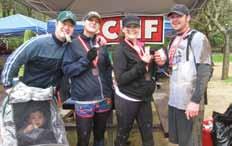
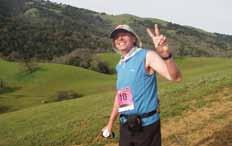
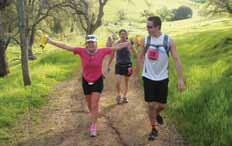

Restoration Winter and Spring 2010
Diablo Restoration Team (DiRT) volunteers joined by East Bay Trail Dogs, REI and SRV Bike Team devoted many days planting, weeding and watering.
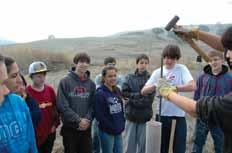
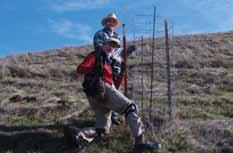
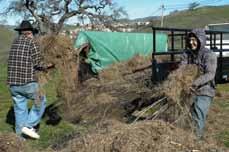
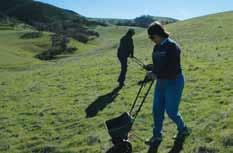
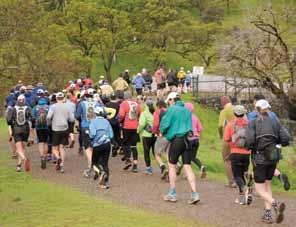
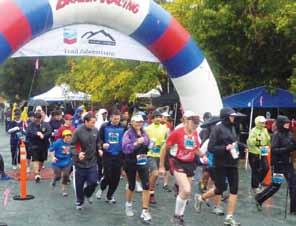
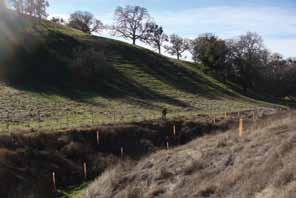
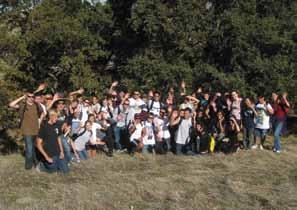 (clockwise) Northgate High students learn to install plant tubes; Dave Sargent and George Phillips load the trailer; Plant tubes protect oaks and buckeyes at Irish Canyon; Northgate students learn about restoration; Kristen Wick and Bob Busch spread seeds on a hillside; Brad Heckman and George Phillips protect trees from cattle.
(Clockwise from left) Friends and family refueling after a 10k; 50kers showing their spirit as they climb the slopes after a quick aid station stop; runners taking off at the start of the 50k in Round Valley; runners head out for the 10k at the Trail Adventure sponsored by Chevron; Elizabeth Domagas and Stephanie Lopez look forward to the barbecue lunch after their 5k; Paul Butler enjoying the peace and beauty along the Diablo Trail.
(clockwise) Northgate High students learn to install plant tubes; Dave Sargent and George Phillips load the trailer; Plant tubes protect oaks and buckeyes at Irish Canyon; Northgate students learn about restoration; Kristen Wick and Bob Busch spread seeds on a hillside; Brad Heckman and George Phillips protect trees from cattle.
(Clockwise from left) Friends and family refueling after a 10k; 50kers showing their spirit as they climb the slopes after a quick aid station stop; runners taking off at the start of the 50k in Round Valley; runners head out for the 10k at the Trail Adventure sponsored by Chevron; Elizabeth Domagas and Stephanie Lopez look forward to the barbecue lunch after their 5k; Paul Butler enjoying the peace and beauty along the Diablo Trail.
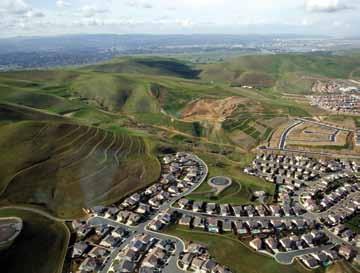 Scott Hein
Scott Hein
Above the Concord Naval Station Regional Park Seeno’s Illegal Faria Annexation in Pittsburg’s Hills
For the third time in a decade Seeno Development Companies have asked the City of Pittsburg to annex the ridgeline southwest of the city. The current proposal would bring the land within the city’s jurisdiction changing zoning to increase residential development.
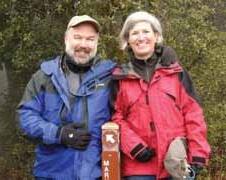
Planning Matters
Diablo Legacy Circle
Scott Hein is a freelance nature photographer whose passion is photographing the native plants, wildlife, and landscapes of the American West – his favorite places being the wild lands and parks surrounding Mount Diablo.
The future of this area is particularly important, since it includes much of the ridgeline and the hills immediately adjacent to the proposed regional park at the Concord Naval Weapons Station. A housing development at the Faria site, on map in red, could place hundreds of homes along the boundary of the new open space, affecting not only ridge-top views, but natural habitat for rare and endangered species.
Save Mount Diablo and Greenbelt Alliance have numerous objections to the annexation. Normal requirements before annexation of county land to a city include a proposed development plan that demonstrates a need for the annexation. The entire package must be approved by the county’s Local Area Formation Commission (LAFCO).
The Seeno Companies are also attempting to side-step a full environmental review as
His wife Claudia Hein teaches chemistry at Diablo Valley Community College. When she joined Scott on SMD’s Board of Directors a few years ago, she said: “The key is to find where you can be most inspired and inspiring.” Hiking and photographing the preserved lands around Mount Diablo inspires the Heins and they want to make sure it will be here to inspire future generations too.
So they have designated a bequest to Save Mount Diablo in their estate plan. “The natural world has always been a major part of our lives and we want to support its preservation even after we are gone. There is no better organization to accomplish this than Save Mount Diablo.”
Gary Rogers hiked the trails of those same parks and his love for the mountain’s preservation will endure because of
legally required. Save Mount Diablo and Greenbelt Alliance contracted with Shute Mihaly Weinberger, a well-known San Francisco legal firm specializing in environmental law, to send legal comments to Pittsburg outlining the legal problems with the project. Contra Costa LAFCO and other public agencies also submitted letters voicing their concerns with the project.
Soon afterward the project was withdrawn from the Pittsburg Planning Commission’s agenda pending revision.
No date has yet been set for placing the item back before the Commission. We’ll keep you posted.
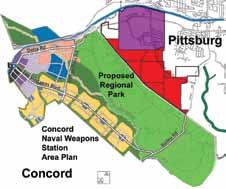
his significant bequest to Save Mount Diablo. We are grateful to all those who have included Save Mount Diablo in their estate plan. Their gifts will have an enduring impact on the mountain and its wildlife for generations to come.
If you are inspired by Gary and the Heins and would like to find out how you can make a lasting gift, please call Julie Seelen at (925) 947-3535.
Diablo Legacy Circle Benefits:
• Knowing you are preserving and defending the mountain now and in the future
• Diablo Watch twice a year
• Personalized certificate
• Annual Report
• Special event invitations
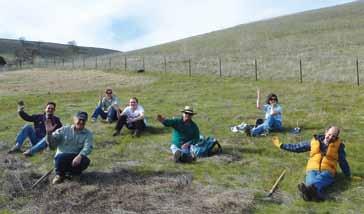
Turning Back the Clock
Restoring Native Grasslands at Mangini Ranch
by George PhillipsRolling hills as far as the eye could see, brilliant wildflower displays wedged between wavy tufts of green. Bay Area settlers observed a seemingly endless native rangeland vastly different than we see today.
At SMD’s 208-acre Mangini Ranch, our Diablo Restoration Team has begun to test methods of restoring native grasslands.
Shaped by California’s long, dry Mediterranean summers, native coast range grasslands were often a mixture of perennial bunchgrasses interspersed with wildflowers. Some of these bunchgrasses evolved with root systems reaching down 20 feet to access ground water during dry months and some live for hundreds of years.
California’s grassland ecosystem began a rapid conversion with the arrival of livestock. Non-native grass seed was transported to the new world in feed and caught in animal hides. Once introduced to California’s fertile soils, invasive grasses and weeds spread uncontrollably across the state.
The most successful invaders are capable of rapid growth, have short life cycles and produce mind-boggling quantities of seed. When landscapes are disturbed by erosion and badly managed grazing, weeds quickly
dominate the native grasses. Tule elk were hunted almost to extinction, fires were suppressed, cattle and sheep multiplied – in a short period of time California’s grassland ecosystems were thrown out of balance.
You may be thinking – well, grass is grass, why does this matter? It’s simple: native grasslands support higher species diversity than non-native annual pasture—most of the state’s endangered species are found in grasslands and are being squeezed out by exotic weeds. Plus, deep roots of native grasses stabilize soil, increase water infiltration, and recycle nutrients.
Native rangeland restoration is complex and can be extremely expensive so we were curious to see if we could find cost effective ways to do larger scale native grass restoration.
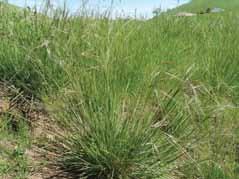
We got a serendipitous opportunity; in 2007 at our Mangini Ranch property we fenced a seven and a half acre area to protect part of Galindo Creek, a pond and a seep. Two years later, our Stewardship Committee members spotted a beautiful stand of purple needlegrass there.
Two main tactics of grassland restoration are expanding existing populations through weed control or grazing management, and reintroduction through
seeding or planting. We decided to generally exclude cattle from the fenced area to encourage the natives.
The next year, we found clumps of native grass growing on about a third of the two dozen flood plain bends in the fenced part of the creek, possibly because of creek disturbance and more abundant water. We found native rye grass higher up in the vicinity of the pond.
Eager to expand the current populations, DiRT removed thatch in October and December from several thousand square feet along Galindo Creek. In the past two months, we’ve seen the native grasses flourish.
Native grass seed costs can range from $10-$100 per pound and $300$1,200 per acre, so we also designed an experimental project for areas above the creek, with the intention of establishing more efficient techniques for larger scale native grass seeding. The plan established sixteen plots and outlined specific treatments within each plot.
In total, we seeded over an acre with custom seed mix of grasses native to the property and of seeds collected locally – Purple Needlegrass, Blue Wildrye, Contra Costa Meadow Barley, and California Brome.
DiRT and botanist Heath Bartosh, a member of SMD’s Board of Directors, will monitor the plots and implement a variety of management techniques to help the seedlings establish and make it through their first summer. Lessons learned from this project will guide future decisions on how we manage and restore native grasses on our properties.
If
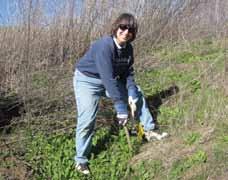
Volunteer Variety
Many Ways to Save Diablo
Save Mount Diablo thanks the over 1,000 volunteers who selflessly donate their time and energy in a wide variety of ways to preserve, defend, and restore Mount Diablo’s open space. There’s always room for more help! We have many volunteer opportunities available. But why should we tell you why to get involved? Here is what our volunteers say:
“Volunteering for Save Mount Diablo has been a wonderful way to offer my particular skill sets to help a just cause...In my case, helping to take hours of video footage from various SMD events, editing them into concise visual messages, and placing them where more people can access the information can only benefit the goals of Save Mount Diablo, whether by event participation or volunteering.”
– PeterArmstrong, Walnut Creek
SMD 2.0
Our New Website
When websites were first popularized nearly two decades ago, Art Bonwell, Save Mount Diablo’s co-founder, created the organization’s first site. Since then we’ve grown with your help and so has the website. We wanted to share more of our projects with you. The time had come to update the site.
Charla Gabert, board member, brought in Alison Martin, who kindly donated some of her time, to design the new website. Clif Bar Family Foundation and Charla generously provided additional funding.
“On a whim, on December 6, 2009, I joined a large group of volunteers for a day of planting for the Habitat Restoration Project at Marsh Creek IV. I had no thought of becoming a DiRT volunteer at the time, but a day in the fresh air, in the country, my hands in the dirt, the sun on my back, in good company and I was hooked.”
– Kristen Wick, Pleasant Hill
“Being a part of Save Mount Diablo, even as a volunteer, is an awesome experience. I’ve made new friends, learned more about the organization mission, and enjoyed helping to preserve a natural wonder in my own back yard.”
–
JimWilhelmi, Pleasant Hill
“When I retired from my job at Los Medanos College, I decided to offer to volunteer at the office in Walnut Creek. Basically I do whatever is needed--from mailings to event prep to picture framing to inventorying tee-shirts--but an ongoing focus for me has been archiving old files, clippings, and records. Great people to work with, and I enjoy my time there.”
– Bev Loomis, Concord“Working with SMD fills a social circle with people of like interests– being outdoors on trails, and helping to protect lands so that we have such trails. It is also rewarding to hear the praise after completing any of the projects – the staff really appreciate the work and talents that we volunteers share with them to accomplish goals.”
– Dick Heron, Danville
This year, after careful planning and lots of review by wonderful volunteers, we launched our new website, SMD 2.0.
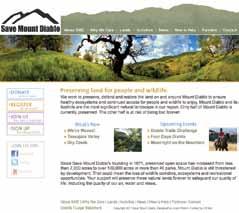
“I enjoy the variety of activities that come with volunteering at Save Mount Diablo; ranging from helping re-purpose donated office furniture for the new office space, picking up wholesale quantities of food for a weekend event, to proof reading a classic botanical treatise written by the founder of the organization. The satisfaction that I am, in many small ways, helping preserve the mountain we all cherish, is rewarding to me.”
– Steve Towle, Pleasant HillThank you to all the volunteers who help Save Mount Diablo preserve, protect, and restore more land for generations to come.
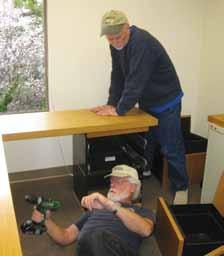
Got skills? Want to volunteer too?
Contact Emily! (925) 947-3535 or eegan@SaveMountDiablo.org
With simpler navigation, it will be easier to check out all of Save Mount Diablo’s projects. The site has more information on land acquisitions, land use planning issues, and restoration projects. The Hike Calendar offers you more ways to enjoy Mount Diablo.
We want to make it easy for you to see what your support does for land preservation. Please let us know what you think! Email Beryl at banderson@savemountdiablo.org.
Diablo Watch is on the website too! To receive this newsletter by email send your request to smdinfo@SaveMountDiablo.org.
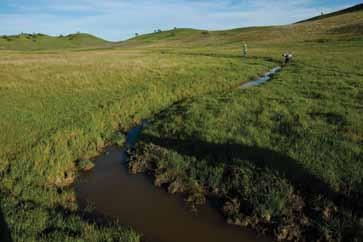
After buying our small Dry Creek parcel, we began to consider how to approach the church. But we had also been discussing the importance of the property with other allies for some time. That approach bore fruit.
The Contra Costa Water District (CCWD) is expanding Los Vaqueros
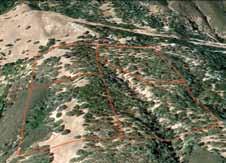
The Oak Hill property’s four parcels.
Five Houses (continued from Page 1)
houses are just the first step. Fire breaks are cleared, driveways and utilities installed, and barns, in-law units and other smaller structures built, all of which can lead to more houses and more fragmentation, as well as to higher land prices.
Because SMD could offer cash and a quick turn around, the two properties respectively were acquired for 27% of previous value and 30% of highest list price.
Moss Rock – 20 acres
This property on Morgan Territory Rd., just south of the Morgan Red Corral
reservoir, flooding other endangered species habitat including some it had previously protected with easements. As a result, CCWD has to preserve additional habitat, at a higher ratio of preservation to impacts than is normally required.
In January, CCWD purchased 340 acres of Ackerman from the church for $2.618 million as part of its package of mitigation. The church retained 50 acres.
The mitigation package hasn’t been completed and wildlife regulatory agencies haven’t yet approved it, but Ackerman looks secure.
and adjacent on two boundaries to Mt. Diablo State Park and another to Morgan Territory Regional Preserve, was just such a development threat. It includes a bridge over Marsh Creek and several house pads on otherwise solid oak-bay woodland slopes rising from one of the highest quality segments of Marsh Creek. Now the property will help consolidate already preserved parkland.
The twenty-acre property was purchased for $425,000 and was brought back from the grave. Its owners acquired the property for a house in 2001, installed several building pads, and other costly improvements, and then in 2006 listed the property for $1.4 million. Three years ago they rejected an SMD offer similar to our agreed upon purchase price.
Oak Hill – Four 10 acre parcels
For years, successive speculators have bid up the price for a group of four 10-acre parcels overlooking SMD’s Wright Canyon property in Morgan Territory—to over $1.3 million—without ever building anything. Together the four parcels form the top of a large blue-oak wooded knoll which was once the actual slopes of
Please respect that both the Ackerman property, and Briones Valley Road (east of Deer Valley) are currently closed to the public. Management strategies will have to be developed to protect the rare species, which may take some time, and access is likely to be limited until then.
Check Save Mount Diablo’s Hike Calendar online under Activities for guided tours of Ackerman and Dry Creek.
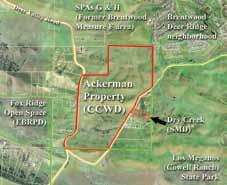
North Peak—you can tell by the onsite peak geology, rocks like chert and serpentine—before Perkins Creek cut through a fracture and divided the two areas. The southern chaparral boundary slopes into Wright Canyon and an eastwest ravine further splits the property.
The threats to the parcels’ resources were four big houses but, given limited access and water, neighbors repeatedly made development difficult. Eventually, investors in the property approached SMD and cut their losses in favor of conservation. We bought the four 10-acre parcels for $87,500 each, in three weeks from start to finish.
The four ten-acre parcels have been purchased for near record low prices of $87,500 each, or $350,000 for a property which had been previously valued at $1.3 million.
SMD will schedule opportunities to see this property. RSVP to gphillips@SaveMountDiablo.org or (925) 947-3535 and see our online Hike Schedule for more info.
New Board & Staff Members

Heath Bartosh
Heath has served on our Land Committee since 2005. A professional botanist for more than 10 years, Heath is a founding principal of Nomad Ecology created in 2004. He holds a B.S. in Natural Resources Planning from Humboldt State University. Heath is proud to serve an organization co-founded by botanist Dr. Mary Bowerman.

Brian Kruse
Brian, a member of the Land Committee since 2007, holds a degree in Psychology and minor in Construction Management from Chico State University. He is an independent contractor with over 35 years of experience. With his knowledge of the Mount Diablo area’s land and history, he possesses a strong commitment and desire to preserve the beauty and wildlife of the mountain.

Jodi Bailey
Jodi joined us in late 2010 as our Land Conservation Manager. She has extensive experience in natural resource management and land use planning. Jodi worked with the San Francisco Regional Water Quality Control Board and The Nature Conservancy to name a few. She holds a doctorate in Geography from U.C. Berkeley with a focus in environmental policy and international conservation.

Shannon Grover
Shannon first found SMD by volunteering with the National Charity League in 2005. While helping us move, Shannon learned of the Senior Administrative Assistant position. Her B.S. in Business Administration from St. Mary’s College along with 16 years of office manager expertise have given her the attention to detail and people skills needed for the job. She is excited to now work for the non-profit she loves.
Thanks to Our Sponsors
Trail Adventure 2010
Diablo Trails Challenge 2011



Dana Halpin
Dana, a Bay Area native and our new Administrative Assistant, replaced Nora in March who is now our Accounting Associate. With a B.A. in Exercise Science from U.C. Davis and five years of previous administrative experience at Stanford University and U.C. Berkeley University, Dana looks forward to melding her passion and experience together at Save Mount Diablo.
Need a Guest Speaker?
Spectacular images of Mount Diablo and the great stories of land preservation on and around the mountain—let one of SMD’s team present to your group or club.
To request a speaker, email Beryl at banderson@SaveMountDiablo.org with the details about your event.
Mount Diablo Challenge 2010
Diablo Watch is printed on recycled paper with soy based ink. Please pass it on to other readers or recycle.
FPO
Save Paper —Read Online. Send a request to smdinfo@SaveMountDiablo.org to receive Diablo Watch by email.
Visit Us Online:
Informed.
Save Mount Diablo on Facebook or Twitter for the most current news and insider information.
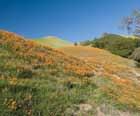
In Memory of
Abbey
Mary & Thomas Carlon
Norma Albrecht
Roger Barrow
Benraz Ali
Sally Dalton
Kai G.E. Anderson
Dianne Anderson
John Arkwright
Nancy Arkwright
Leo Banducci
Virtudes Banducci
Mr. Bigglesworth
Susan & Robert Best
Clarence Blair
Janine Marin
Bill & Alice Pomidor
Mary Bowerman
John & Esther Harris
Jerry Bowman, Vet WWII
Ethyl Bowman
Steven Broz
Lescure Foundation
Gisela Burns
Sandra & Mason Stober
Carl B. Casey
Gayle Servin
Priscilla Colby
James & Nancy Chang
Robert Colby
Allan & Jennifer Deal
Doris Klein
Bill Collins
Ruth Collins
Jim Davidson & Yolan
Fairgrief
Mary Schwartz
Von (Alice) DeLoach
Wanda Dalmas
Jack Ditzel
Janis Brooks
Bruce Fogel & Linda Andersson
Mike & Cindy Hassan
Gun Johnston
Scott Dowd
Linda Burton
Jane Dubitzky
Roger Epperson
Richard Davis & Sandra Jones
EBRPD, AFSCME Local 2428
Greg Page
John Farley
Paul Farley
Karen Stepper
My Father
Martin Enni
Anna Louise Ferri
Lawrence Ferri
Bryant Fischback
Marvin & Carolyn Schick
Elinor Fraser
Tom & Carol Hoesly
Barry Gilmore
Robert & Carol Lowitz
Tribute Giving
Thank you to all of our supporters. Members are listed in our Annual Report. Tribute gifts, donations in honor or memory of loved ones, are listed below. Your generosity saves the mountain!
Virginia Guerin
Marguerite & John Harrell
Ruth Hansen
Keith Hansen
Dr.
Sam Hauer
Harold & Donna Fogel
Jean P. Hauser
Barbara Hauser
George Helder
Carol & Glenn Robak
Charles Hoonan
Charles Shaddle
Carole Kaufman
Julian Kaufman
Harlin Kessel
Louise Moises
My Husband, Albert and Daughter, Lauri Klobas
Ruth Klobas
My Precious Pets, Koko, Whitney & Jacques
Kay Brezinsky
Michael E. Lamp and Thomas H. Befus
Mary Lam
Shannon Loomis
Scott & Claudia Hein
Mackay
Kathleen & Brian
Kearnes
Margaret (Peggy) Mahler
Barbara Mahler
Marc
Patricia Tibbetts
Edith Mazzei
Cheryl & Arthur
Watkins
Kate McKillop
Stephen Taylor
Kay Lee Meyer
Colton Meyer
Miriam
Clayton Englar
Hank Moises
Louise Moises
Janet Montes
Terry & Glenn Gonzalez
Our Mother
Steve & Donna Mazaika
Bob Mozek
Margaret & Kenneth Mozek
Carl R. Myers
Ada Myers
Mary Nadeau
Graydon & Holly Eliot
Rose Naredo Gunderson
Sandy Lura
Robert Ornduff
Richard & Linda Beidleman
Paul, Ellen Grace, P.C.
Kimble and Mrs. Charles (Grandma) Dunn
Steven Raymond
Clarence Pomidor
Patricia & John Pomidor
John A. Raventos
Patricia Donegan & kids
Walter Reifschneider
Rose McKinnon
John & Linda Van
Heertum
Captain Carl Rosene
Liz Redon
Mary Jane Scanlon
Barbara Walters
Dr. Robert (Bob) Scharf
Alice LaDove
Bob & Ann Sutherland
Patricia & Simon Trapani
Mildred Whittam-Nelson
Lois Seguin
Al Seguin
Sioux
Ruth Stone Feldman
Skyler
Judith Peake
Niel Snortum
Elizabeth Snortum
Bernice Strube
Robert O’Donnell
Grace William
John Sumpter
Cheryll Sumpter
Vivian, Sutton’s Mother
Judy Adler
Howard Thomas
Judy Canright
Brie & Tasha Vasco
Lisa & Louis Vasco
Jim Veikos
Mary Veikos
Rochelle Ward
Lois Blazic
John Waters
EBRPD, AFSCME Local 2428
George Weldon
Betty Weldon
John Wells
Dorothy Wells
Delphina Williams
Mary Ann Halvorson
Bob Wisecarver
James & Shirley Lynch
Bob Woore
Arlene Pearson

In Honor of
Seth Adams
Laura Baker & Lewis
Lubin
Michael O’Donahue & Robert Landry
Burt Bassler
Elissa Bassler
Mr. & Mrs. Rick
Bernskoetter
Ronald & Karen Cassano
Andrew & Mireille Bischel
Marc & Kathy Berger
Fritz Boege
Helene & William Woods
Art Bonwell
Neal & Lind Higgins
Dr. & Mrs. Jeff Bryan
Ronald & Karen Cassano
Miss Amy Bryan
Ronald & Karen Cassano
Mr. & Mrs. Kevin Bryan
Ronald & Karen Cassano
Mr. & Mrs. Norm Bryan
Ronald & Karen Cassano
Our Moms
James & Gloria Redmond
Mr. & Mrs. Don Cassano
Ronald & Karen Cassano
Ron & Karen Cassano
Kathy Fuller
Community Concern 4 Cats
Jay & Jane Jennings
Cossart Family Children
Patricia Cossart
Shawn, Pam & Jessica
Cullen
Vivian Boyd
Paulette Cziske
Liz Redon
Don
Susan & Mark Friedman
Audrey & Carl Down
Kathy Down & Gregory
Kelly
Mary Dubow Howard
Philip Dubow
Each Other
Louise & George Heath
Elwell Family
Carol Baxter
AnMari Ericsson
Diana McKennett
Peggy & Spiro Farrugia
Elisa Dowd & Douglas Graver
My Cousin, Gail
Mary & Sterling Gray
John Galloway
Cathy Brown
Our Grandson
Patricia Avalos
Susan & Phil Grover
Tim Rich
Happy Birthday Joyce
Gellepes’ Mom!
Anonymous Scott & Claudia Hein
Michael & Jane Larkin
Dr. Greg & Mrs. Ann
Hummel
Gene & Jeannine Hummel
Brad Kelly and Corine
Hawkins
Douglas Kelly
Kate Kunnes
Louie-Marsh Family Fund
Lawson Family
Nancy & Leonard
Slootmaker
Sharon Layton
Thomas Smoot
Juanita Luther
Phyllis & Jerry Hobson
Geoff & Val Meredith
Thomas Meredith &
Laurie Wunder
Nala
Mary Hasson
Shirley Nootbaar
Charlotte Panton
Janet Oman
Mr. Oman & Mr.Crummer
June Pantages
Jerri Long
Mr. & Mrs. Bill Rassmussen
Ronald & Karen Cassano
Philip E. Reynolds
Steve & Paula Reynolds
Jean & Frank Silvey and the Hartman Family
Katherine Silvey
Barbara Jean Smith
Shannon Smith & Russell Overbeck
Mildred Snelson
David & Karen Snelson
TeleManagement Technologies, Inc
Mark Hearn
The many wonderful hours of hiking, camping and appreciating the wonder of nature with Lafayette Boy
Scout Troop 224
Cathy Luginbill
David Theis’ Birthday
Jacqueline & Paul Royce
Jacquette Theis
Glorya Weber
Joan Sasaki
Scott Zimmerman’s Birthday
David & Judith Gavin

Kristin Chambers & Bruce
Merl’s Wedding
David & Norma Stark
My Son , Scott Dowd
Tedd Dowd
Lois & Jerome Elson
Janise Trezise
Friends
Jim Treuel & Terri
Costello
Carol Pollock
Roy & Carol Pollock
Trowbridge Family
Thomas & Lynn Trowbridge
Corporate Match
Bank of America
Bank of the West
Chevro
Clorox
Pepsico Foundation
The Lubrizol Foundation
United Way Bay Area
West Marine Products
Contributions were made from July 1December 31, 2010.
1901 Olympic Blvd., Suite 320
Walnut Creek, CA 94596
Address Service Requested
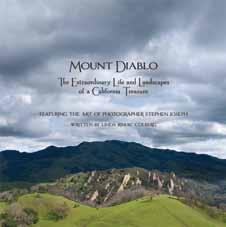


Our Mission
New Office Open House
Stephen Joseph Book Signing and Slide Show
Wednesday, May 18, 2011 4:00 to 8:00 pm
You are cordially invited to tour Save Mount Diablo’s wonderful new office. Meet SMD staff, visit with fellow members, and enjoy refreshments.
In addition, take this opportunity to check out the best new photo book of Mount Diablo, Mount Diablo The Extraordinary Life and Landscapes of a California Treasure. Stephen Joseph, photographer, and Linda Rimac Colberg, writer, will be on hand to sign their new books available to purchase. A slide show of the images will be shown in the conference room. Please R.S.V.P. at (925) 947-3535







To preserve Mount Diablo’s peaks, surrounding foothills, and watersheds through land acquisition and preservation strategies designed to protect the mountain’s natural beauty, biological diversity, and historic and agricultural heritage; enhance our area’s quality of life; and provide recreational opportunities consistent with the protection of natural resources.
What We Do
Preserve natural lands through acquisition and cooperative efforts. Defend Mount Diablo and its foothills from threats of development through land use planning and public education.
Restore habitat prior to transfer to a public agency for permanent preservation and public use. Enjoy Diablo’s parks through events & recreational opportunities.
Why We Care
This is our home. Preserving natural land forever means safeguarding our quality of life, including our air, water, and views. Only half of Mount Diablo has been preserved. The other half of the mountain, over 80,000 acres, is privately owned and still threatened by development. That means risking the loss of wildlife corridors, ecosystems and recreational opportunities.
